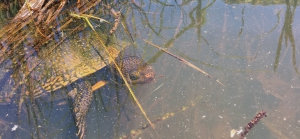
We have been discussing our work with turtles for the last few weeks, but what actually makes Blanding’s turtles special, why are their populations struggling, and why is their conservation important? This week we want to shed some light on the natural history and importance of the stars of our summer research show: the Blanding’s turtle.
The Blanding’s turtle (Emydoidea blandingii) comes from the family Emydidae which consists of pond turtles such as red-eared sliders and painted turtles. Blanding’s are classified as semi-aquatic turtles meaning that they divide their time between water and land between wetlands. They prefer shallow waters not much more than a few feet deep, leaving deeper ponds and lakes to more aquatic species like their cousins, the painted turtle. Theory suggests that Blanding’s are not as competent swimmers relative to species that thrive in deeper waters. Females are known to travel great distances to find a suitable nesting site as well as look for new habitat and resources. Many times this summer when we find Blanding’s they tend to be basking on dirt or dead brush piles in or around these shallow ponds and marshes.
Blanding’s are omnivorous meaning that their diets consist of both plant and animal material. From the shallow ponds they inhabit, they consume small fish, crustaceans such as crayfish, insects, and frogs. They also will eat vegetation surrounding the ponds including berries and plant matter.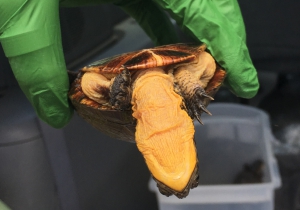
Unique characteristics of the Blanding’s turtle include their coloration, carapace shape, and of course their signature smile. A Blanding’s turtle has a dark brown/black shell, sometimes with bright yellow spots on the top shell (carapace), providing good camouflage in the more heavily vegetated areas. Their he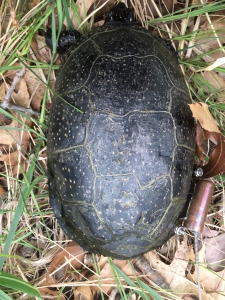 ad and legs are also dark while their chin and throat is a bright, vibrant yellow. Their carapace is more domed than the painted turtles who they share ponds with, and tends to dome more with age. A unique feature the Blanding’s turtle is their curved mouth which is shaped so that edges of the top beak curls upward, portraying these turtles with a deep smile.
ad and legs are also dark while their chin and throat is a bright, vibrant yellow. Their carapace is more domed than the painted turtles who they share ponds with, and tends to dome more with age. A unique feature the Blanding’s turtle is their curved mouth which is shaped so that edges of the top beak curls upward, portraying these turtles with a deep smile.
Throughout much of their natural range (Great Lakes region), the Blanding’s turtle is listed as threatened or endangered on the IUCN Red List. The main causes of population decline include habitat loss and fragmentation from human development, genetic diversity loss due to small population size, low juvenile recruitment, and predation. Human development and ecological imbalance such as an abundance of beavers has destroyed or altered areas where there are semi-permanent ponds that Blanding’s live in. For example, in Illinois, the extirpation of large predators has led to an increase in beaver populations whom make dams creating deeper ponds with little water flow. The Blanding’s prefer shallower areas and so are pushed out of these ponds when beavers move in. Another reason it is hard for Blanding’s to survive in disturbed areas is their delayed maturation, reaching sexual maturity at 14-20 years of age. Female juveniles need to survive an 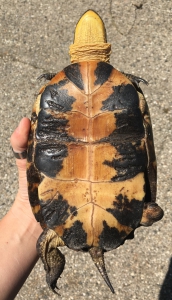 abundant amount of seasons in order to become productive egg-layers and in many areas, the rate at which juveniles are dying off is not sustainable for producing a healthy adult population. Major predators to turtles in general are raccoons, skunks, crows and foxes. When there is an abundance of predators it negatively affects the survival rate of our Blanding’s friends. Some of the turtles we have encountered this summer have had signs of predator encounters including what appears to be bites taken from shells or scarred/damaged appendages. Mesopredators like raccoons are known to be destructors of Blanding’s nests so much that in Lake County from 2004-2010 only 7.7% of nests were able to hatch without being protected from predation by the Lake County Forest Preserve.
abundant amount of seasons in order to become productive egg-layers and in many areas, the rate at which juveniles are dying off is not sustainable for producing a healthy adult population. Major predators to turtles in general are raccoons, skunks, crows and foxes. When there is an abundance of predators it negatively affects the survival rate of our Blanding’s friends. Some of the turtles we have encountered this summer have had signs of predator encounters including what appears to be bites taken from shells or scarred/damaged appendages. Mesopredators like raccoons are known to be destructors of Blanding’s nests so much that in Lake County from 2004-2010 only 7.7% of nests were able to hatch without being protected from predation by the Lake County Forest Preserve.
So why care about saving an endangered species? Biodiversity! It is important that we conserve and save native plants and animals to prevent extinction of natural ecosystems. Losing a single species can result in a detrimental domino effect on the rest of the ecosystem in which that species resides. Most significantly, species loss will effect the natural food ch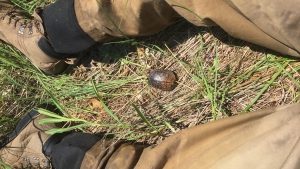 ain. Each species contributes to maintaining a healthy equilibrium of all populations and resources that even we humans rely on. Ecosystem equilibrium can prevent invasive species development as well as movement into new habitats such as predators moving into residential areas. The thought of mesopredators (i.e. raccoons) and larger predators (i.e. coyotes) moving into local neighborhoods is unappealing to many. The benefits of preserving Blanding’s turtles as well as other threatened and endangered species is crucial to environmental health and stability.
ain. Each species contributes to maintaining a healthy equilibrium of all populations and resources that even we humans rely on. Ecosystem equilibrium can prevent invasive species development as well as movement into new habitats such as predators moving into residential areas. The thought of mesopredators (i.e. raccoons) and larger predators (i.e. coyotes) moving into local neighborhoods is unappealing to many. The benefits of preserving Blanding’s turtles as well as other threatened and endangered species is crucial to environmental health and stability.
On a lighter note, here are some fun highs and lows for the week:
High: As team vet student, we have compiled over 100 turtle samples! We have performed over 100 blood draws, over 100 DNA swabs and over 1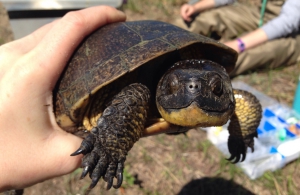 00 physical exams. We have created and read over 100 hemocytometers, performed over 100 PCV/TP tests, created over 200 blood smears, and have begun to extract some of the DNA from our collections. It is cool to know after all of our hard work during the week we can see this number and realize we are obtaining so much data!!! It’s awesome!
00 physical exams. We have created and read over 100 hemocytometers, performed over 100 PCV/TP tests, created over 200 blood smears, and have begun to extract some of the DNA from our collections. It is cool to know after all of our hard work during the week we can see this number and realize we are obtaining so much data!!! It’s awesome!
Low: With all of our samples our lab work has taken us into some long and late nights – but it wouldn’t be a true veterinary project without exciting hours would it? Some days we have seventeen samples to work up and others we have two. I think the only thing we can complain about, even when we are in the lab for an extended amount of time is that we are hungry, and that just calls for a rewarding ice cream stop on the car ride home. The lab work itself is exciting and fairly new to both of us so every test we perform and sample we analyze we feel like we are building our skills and becoming better veterinarians. The more samples, the better. We would take a late night in the lab any day – well, most days.
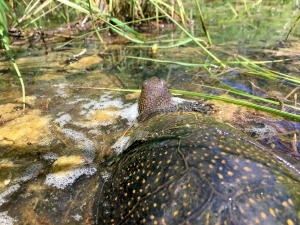
Save the turtles, save the world!
